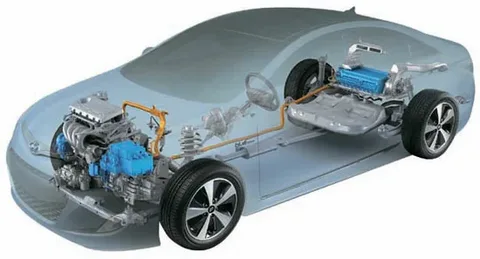-
Feed de Notícias
- EXPLORAR
-
Páginas
-
Blogs
-
Courses
-
Movies
Hybrid Systems: A Practical Pathway to Low-Emission Mobility

Introduction
The Hybrid System in Automotive Market is expanding as the global transition to cleaner mobility accelerates and manufacturers bridge the gap between internal combustion engine (ICE) vehicles and fully electric vehicles (EVs). Hybrid systems combine an ICE with one or more electric motors and a battery to improve fuel efficiency, reduce emissions, and enhance driving performance. These systems operate in multiple modes—such as electric-only, engine-only, and combined power—to optimize energy usage. With rising fuel prices, stringent emission regulations, and consumer demand for eco-friendly mobility, hybrid vehicles have emerged as a practical and cost-efficient alternative for both personal and commercial use. Automakers are increasingly introducing Mild Hybrid (MHEV), Full Hybrid (HEV), Plug-In Hybrid (PHEV), and Strong Hybrid systems across their product lines. The market is projected to grow at a CAGR of around 8–10% over the forecast period, supported by government incentives, advancements in battery technology, and the increasing shift toward sustainable transportation solutions.
Market Drivers
Stringent emission standards imposed by governments worldwide are a major driver for hybrid system adoption, as hybrid vehicles emit significantly less CO₂ than traditional ICE vehicles. Rising fuel costs and consumer awareness about fuel efficiency are accelerating demand for hybrid vehicles. Advancements in battery technology, regenerative braking, and power electronics are improving hybrid system performance and affordability. Hybrid systems provide range confidence compared to fully electric vehicles, making them attractive in regions with limited charging infrastructure. Increasing fleet electrification by taxi services, logistics firms, and ride-sharing platforms is further boosting adoption. Automotive OEMs are integrating hybrid variants across popular models to meet emission compliance targets while maintaining performance and driving comfort. Additionally, growing urbanization and stricter city driving emission rules encourage hybrid vehicle use.
Market Challenges
Hybrid systems increase vehicle cost due to complex dual-powertrain architecture, advanced electronics, and high-voltage battery packs, limiting adoption among cost-sensitive consumers. Long-term maintenance costs can be higher due to more components and specialized servicing needs. Limited driving range in electric-only mode for many hybrid models may discourage buyers who seek full electrification. Battery degradation over time reduces efficiency and increases replacement expenses. Hybrid systems add weight to vehicles, impacting performance if not engineered efficiently. Charging limitations for PHEVs in regions lacking infrastructure also restrict widespread usage. Supply chain dependency for batteries, semiconductors, and rare-earth materials creates pricing and availability uncertainties. Additionally, lack of consumer awareness in developing markets affects hybrid system penetration.
Market Opportunities
Growing acceptance of hybrid systems as an intermediate step toward full electrification presents strong opportunities for market expansion. Development of next-generation hybrid systems with higher electric-only range, lightweight components, and improved energy recovery offers innovation potential. Mild hybrid 48V systems provide cost-effective electrification for mass-market vehicles, creating large-scale adoption opportunities. Expansion of Plug-In Hybrid (PHEV) infrastructure will increase appeal for customers who want EV-like benefits with ICE flexibility. Hybridization of commercial vehicles, buses, and delivery fleets presents new revenue streams for manufacturers. Integration of AI-driven energy management systems can enhance efficiency, predictive battery usage, and driving behavior adaptation. Collaborations between OEMs, energy companies, and battery suppliers will accelerate technological innovation and cost reduction. Additionally, hybrid powertrains for two-wheelers and three-wheelers in Asia present a high-growth market.
Regional Insights
Asia-Pacific dominates the Hybrid System in Automotive Market due to strong adoption in Japan, China, and South Korea. Japan leads globally, with hybrid vehicles forming a large share of the national automotive fleet and brands like Toyota and Honda pioneering hybrid technology. China is rapidly growing as government policies support electrified mobility and hybrid systems become popular as a transition technology. Europe holds a significant share due to strict emission norms, low-emission zones, and tax incentives encouraging hybrid vehicle ownership across Germany, France, the UK, and Nordic countries. North America shows increasing hybrid adoption, led by the U.S., where fuel economy regulations and rising EV interest support PHEVs and HEVs. Latin America, the Middle East, and Africa are at early stages of hybrid adoption but show long-term potential with rising urbanization and fuel cost pressures.
Future Outlook
The future of the Hybrid System in Automotive Market will be shaped by improved energy storage, lightweighting, and software-defined powertrain control. Strong hybrids and plug-in hybrids will continue gaining popularity as practical solutions for regions transitioning gradually toward EVs. Solid-state batteries, high-efficiency motors, and integrated e-axle systems will enhance hybrid system performance. 48V mild hybrid systems will expand into mainstream passenger vehicles, reducing cost barriers. Predictive energy management powered by AI and IoT will improve fuel economy and driver experience. As emission policies tighten, hybridization will increasingly become standard across multiple vehicle classes, including SUVs, premium sedans, two-wheelers, and commercial transport. In the long term, hybrids will act as a crucial stepping-stone technology enabling smooth transition to fully electric mobility.
Conclusion
The Hybrid System in Automotive Market is evolving as global mobility shifts toward sustainable, efficient, and low-emission transportation solutions. Hybrid systems offer an optimal balance between performance, fuel savings, and environmental benefits, making them a preferred electrification pathway in many regions. Despite higher initial cost, battery reliance, and infrastructure limitations, continuous technological advancements and supportive government policies are driving strong market growth. As automakers expand hybrid lineups and integrate advanced energy management systems, hybrid vehicles will continue to play a pivotal role in the global automotive transition. The market is set for long-term expansion as consumers seek eco-friendly and practical alternatives to conventional ICE vehicles.
- Art
- Causes
- Crafts
- Dance
- Drinks
- Film
- Fitness
- Food
- Jogos
- Gardening
- Health
- Início
- Literature
- Music
- Networking
- Outro
- Party
- Religion
- Shopping
- Sports
- Theater
- Wellness


